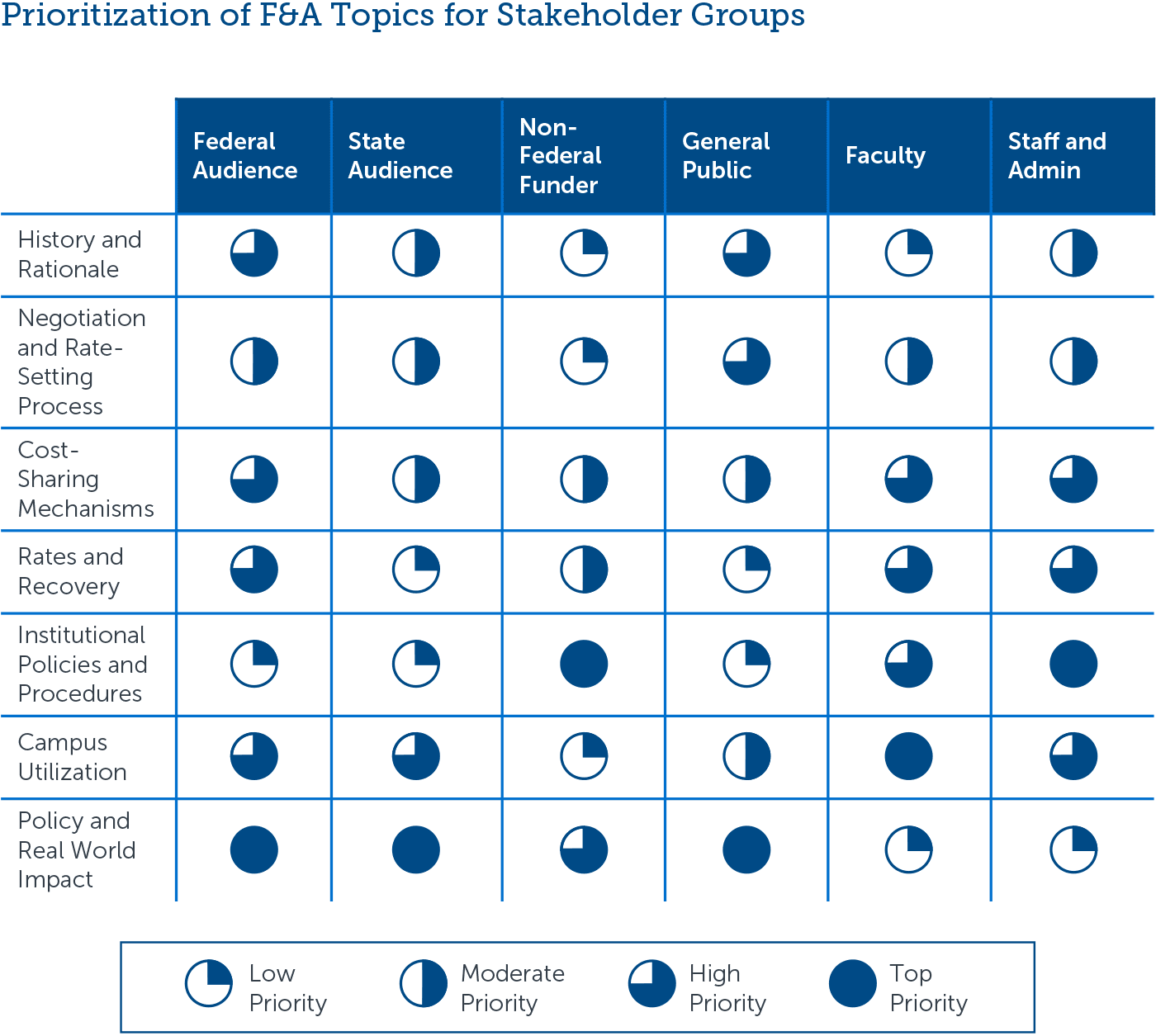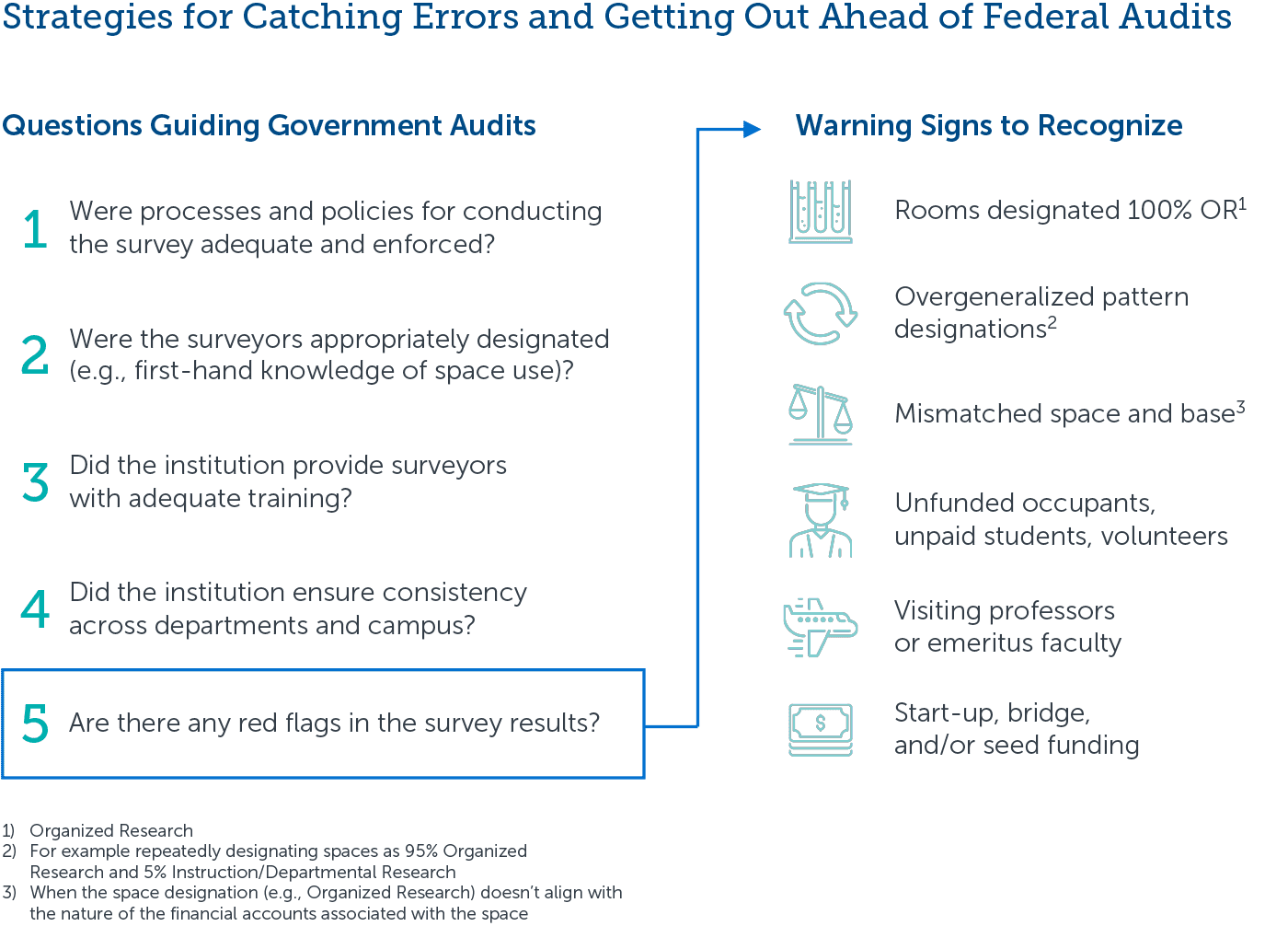Adopt a Proactive Approach to Facilities and Administrative (F&A) Funding
While the research community staved off the threat of a proposed 10 percent cap on facilities and administrative (F&A) funding in 2017, chief research officers (CROs) were forced to confront persistent shortcomings in their F&A communication, recovery, and investment strategies. These shortcomings require universities to rethink their approach to a funding structure as old as the research agencies that fund them.

Develop audience-specific messaging for F&A communications
CROs and their teams should combine broad, general F&A messaging with targeted messages that align with stakeholders’ priorities and interests, including federal lawmakers, state lawmakers, faculty and staff, and the public at large. These messages should include:
- The history of F&A
- What F&A does (and doesn’t) fund on campus
- The university’s current F&A rate
- How the university administers F&A funds
After prioritizing the right topics for the targeted stakeholder, research leaders should adjust their messaging to ensure the message will resonate with that particular audience. For help, access the Stakeholder-Targeted Messaging Matrix in Tool 1 of our F&A Communications Toolkit.


Maximize space audits to improve return rate
With the 26% administrative cap still in place, the opportunity for universities to increase their negotiated rate is in the facilities number. Properly tracking research space usage is critical to being properly reimbursed for costs incurred on operations, maintenance, and utilities. Despite the importance, most universities allow space audits and surveys to be conducted with little central guidance and supervision. Research leaders can correct this by:
- Reviewing past feedback for areas of improvement
- Starting the process early, especially on training auditors
- Institute more frequent data collection practices
- Double-check space inventory accuracy
- Develop more in-depth training materials, like FAQs and practice scenarios


Correct mistakes in industry contracts, foundation gifts, and waiver use
Once gaps in the space audit are addressed, research leaders must turn their attention to misinformation and inaction on their effective rate. Most universities identify these mistakes on non-federal contracts, especially in negotiations with industry partners and foundations.

-
For industry, universities must hold strong that industry cannot receive a "better deal" than the federal government, and therefore must be assessed the full rate.
One way universities go about this is by only giving industry the total cost of work estimates, which do not explicitly distinguish F&A from direct costs. There are other negotiation levers to pull to bring down the cost.
-
For foundations, the problem is typically a lack of understanding that foundations can (and should) be charged at least some F&A as this work ends up costing the university.
Research leaders can determine based on costing and strategic partnerships if there is a project cap under which they will waive all F&A (e.g., any grant below $10,000 will have F&A waived). Research administrators should also attempt to discern if the foundation has an established F&A rate or if the university has used a standard rate in the past. Finally, universities must move away from approaching all foundations in the same way and instead adopt a partnership prioritization approach.
-
F&A waiver policies need to be updated and better enforced to ensure they are not being abused.
Policies should include examples of when it is (and is not) appropriate to waive F&A. They should also articulate the ramifications of under recovery on department and college leaders.
Align F&A investments with strategic research goals
At their core, F&A dollars are a reimbursement for costs the university has already incurred. Unfortunately, too many faculty leaders view these dollars as “pennies from heaven” that can be deployed as they see fit.
These dollars should be reinvested in the research enterprise, specifically in areas of strategic growth for the university. Below are several models for how these distributions are set up at profiled institutions, along with pros and cons to consider when vetting whether each model is a good fit for campus.

Spectrum of Strategic Research Investment Models
-
Most to central administration (non-research): F&A dollars are returned to the general university fund and/or to the Provost's office
Pros: Centrally managed, removes pressure from CROs, better aligned to university strategy
Cons: Limits CRO control, research may not be prioritized -
Most to research office: F&A dollars are returned to the Research office for strategic reinvestment and support services
Pros: Allows for significant reinvestment in research, provides CRO with discretionary funding to support strategic research initiatives
Cons: Pressure to make political (not strategic) decisions, results in all those seeking funds to ask the CRO first -
Split between central administration and deans: A portion of F&A dollars are returned to the general fund and/or Provost's office, while the remainder is allocated to colleges
Pros: Removes pressure from CROs, empowers deans while preserving some central funding
Cons: Limits CRO control, research may not be prioritized, deans are unfamiliar with how to invest strategically -
All/most to deans and/or departments: F&A dollars are distributed to colleges and/or departments for decentralized use
Pros: Removes pressure from CROs, empowers deans and chairs to make budgeting decisions
Cons: Limits CRO control, research may not be prioritized, deans and chairs are unfamiliar with how to invest strategically, inequity across colleges can lead to tensions -
Large portion (25%+) returned to PIs: A portion of F&A returns are distributed to the individual PIs that received the awards
Pros: Provides direct incentive for pursuing research dollars, reduces faculty skepticism of F&A process, encourages financial responsibility of fund use.
Cons: Limits CRO control, research costs may not be prioritized, deans and chairs are unfamiliar with how to invest strategically, difficult to track spending
This resource requires EAB partnership access to view.
Access the roadmap
Learn how you can get access to this resource as well as hands-on support from our experts through Strategic Advisory Services.
Learn More